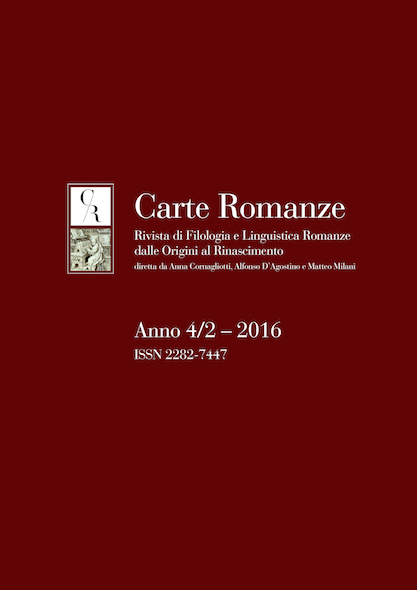Per l'analisi dell'oralità nei cantari
Contenuto principale dell'articolo
Abstract
Il cantare, genere di difficile definizione, si estende per un arco temporale di quasi due secoli (tra 1300 e 1500) e si identifica con un corpus di testi decisamente eterogeneo. Volendo approfondire il discorso sulla tradizione performativa nei cantari e sulla complessa oscillazione tra oralità e scrittura riconoscibile in molti testi canterini, si analizzano una serie di tracce e indizi di performatività che rendano conto dell'effettiva consistenza recitativa dei testi. Tali elementi si indagano sia nella veste più esterna ed esplicita, fatta di formule e motivi ricorrenti, sia nell'analisi delle strutture retoriche e formali: la particolare struttura dell'ottava, l'andamento paratattico, le riprese e le ripetizioni, le rime identiche, desinenziali e rabberciate, l'anisosillabismo, la generale tendenza alla coincidenza tra metro e sintassi che limita al minimo i fenomeni di enjambement e sovrainarcature. La schedatura di alcuni testi della tradizione, alla ricerca delle tracce d'oralità individuate, e il confronto tra le relative schede, suggeriscono una riflessione sul genere e sui testi.
The cantare, a genre which is difficult to define, spreads along a two centuries space of time (between the XIVth and the XVIth century) and can be identified with a corpus of greatly varied texts. A broad series of performativity traces and clues, able to give further evidence of the real recitative essence of the texts, will be anlysed, aiming to ivestigate the question on the performative tradition of the cantari and on the complex alternation between orality and writing, easily detectable in many canterini texts. In this study we will investigate all these components both from their outer and more explicit appearance, with all its formulas and recurrent themes, and through the anlysis of rhetorical and formal constructions, such as: the peculiar structure of the octave, the paratactic construction, references and repetitions, identical, desinantial and cobbled together rhymes, anisosyllabism, a common and general use of correspondence between metre and syntax, minimizing the cases of enjambement. The filing of some texts from the tradition, searching for traces of orality, identified earlier, and the comparison among the respective files, urges to a closer examination of the genre and the texts.
Dettagli dell'articolo
Carte Romanze si serve di una licenza  Creative Commons. Attraverso la licenza CC-BY-NC-ND gli autori conservano tutti i diritti economici e concedono alla rivista il diritto non esclusivo di pubblicazione, permettendo a chiunque di scaricare il contributo, di leggerlo e stamparlo. Ogni riuso deve prevedere la citazione virgolettata (o comunque riconoscibile), garantendo all’autore la proprietà intellettuale di quanto citato, e segnalando sempre e comunque la rivista come fonte (con l’indicazione dell’annata, del volume e delle pagine). Non è invece concessa a nessuno la modifica del contributo né il riuso per creare opere secondarie.
Creative Commons. Attraverso la licenza CC-BY-NC-ND gli autori conservano tutti i diritti economici e concedono alla rivista il diritto non esclusivo di pubblicazione, permettendo a chiunque di scaricare il contributo, di leggerlo e stamparlo. Ogni riuso deve prevedere la citazione virgolettata (o comunque riconoscibile), garantendo all’autore la proprietà intellettuale di quanto citato, e segnalando sempre e comunque la rivista come fonte (con l’indicazione dell’annata, del volume e delle pagine). Non è invece concessa a nessuno la modifica del contributo né il riuso per creare opere secondarie.
Quando siano rispettate le indicazioni di cui sopra, non è necessario richiedere ulteriori permessi di utilizzazione del materiale né all’autore né al comitato scientifico.

